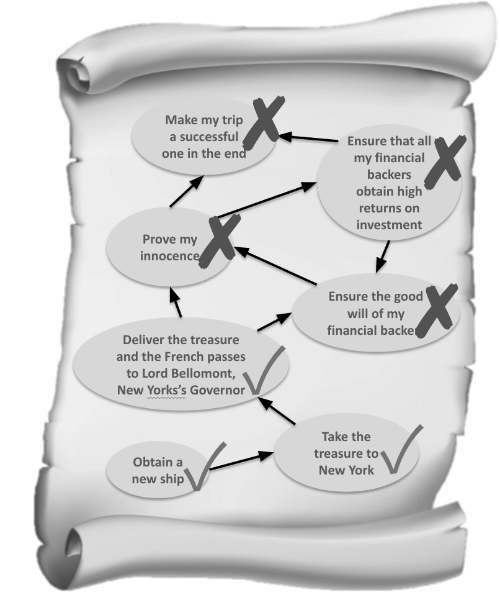Strategy vs. Tactics is one of the most written-about topics in business, but most business books seem to explain it in ways that hinder both the clarity of thought and the establishment of good conceptual frameworks.

Are strategy and tactics really different concepts, or just different levels of the same thing? If different, in what do they differ? Should they be handled differently? The goal of this blog-post is to describe strategy and tactics from the point of view of the Captain of a pirate ship, in the hope that the analogy will be sticky enough to allow remembering the concepts the next time this topic comes up. Let us first set up the context, and then clarify the concepts.
A Pirate’s conundrum
In March 1699, after a years-long voyage as a privateer, Captain Kidd found himself in the Caribbean commanding a captured, undermanned, treasure-laden vessel (the Quedagh Merchant). There, he learned that he and his crew had been declared pirates and were to be arrested. The accusation of piracy stemmed from having captured two ships (the Quedagh being one of them), which led to an immense diplomatic and political upheaval. However, Kidd had in his possession the French passes presented to him by those ships, which made the captures legal (at least technically), and thus constituted his proof of innocence against the piracy accusations.

The situation was dire. The English, Dutch, and Portuguese navies would capture or destroy him on sight. If he was captured, he was likely to be sacrificed without a fair trial. Everybody wanted a piece of him.
The strategy
This is the type of situation where one can certainly use a well-designed strategy. Here is the set of strategic objectives (and their interrelations) that Kidd seems to have adopted; that is, his strategic map:

The chosen strategy seems sensible. If he were to prove his innocence from the piracy accusations, he had to ensure that the French passes (the only documents capable of doing so) were safely delivered to the proper authorities. Furthermore, proving his innocence would require the goodwill of powerful allies, the most obvious of which were the powerful financial backers of his privateering adventure. Not only was Lord Bellomont one of these backers, he was the Governor of New York. All in all, this made him the best possible ally and entry point into the system to prove Kidd’s innocence, given that proving the legality of Kidd’s captures would have entitled him to his share of the expedition profits. Delivering the passes and treasure to Bellomont was, therefore, the sensible thing to do. To reach Bellomont, however, Kidd needed to navigate to New York undetected, lest he be captured underway. This implied obtaining a new ship, because the moorish-built Quedagh was big and highly conspicuous. Overall, his was a sound strategy.
The outcome
Captain Kidd did reach the lower three objectives defined in his strategy. He managed to buy a new ship, transfer a considerable part of the treasure to it, and then navigate to New York undetected (the Quedagh was left behind with the remainder of the treasure), finally reaching Lord Bellomont with the passes and part of the treasure. His undoing was in how he did these things (his tactics), which in the end made it impossible for him to reach the remaining defined strategic objectives and, ultimately, led to his untimely death.

Overall, his tactics to reach the strategic objective “Ensure the goodwill of my financial backers” were very thin. They relied solely on convincing Bellomont, who would then influence the remaining backers and the central powers. If Bellomont reported that the passes were valid, the piracy charges were unfounded, and Kidd had willingly and honestly performed his assigned commission, then the remaining backers would certainly have been won to Kidd’s cause, for self-interest if nothing more. His tactics thus had a single point of failure (convincing Bellomont), and one whose probability of failure was unknown. It was a very thin piece of tactics, and it failed miserably.
Lord Bellomont quickly came to consider Kidd as a hostile, lying, and deceiving rascal, and not only imprisoned him, but did his best to portray Kidd in the worst possible light to the central powers in London. In fact, he even came up with a backup plan to hang Kidd if the piracy charges happened to be waived.
Having failed to reach that particular strategic objective, the remaining objectives fell like a house of cards. Kidd found himself without allies, with not a single relevant person interested is sustaining his innocence, and with an increased number of powerful people committed to his demise. The end was unavoidable. He could not prove his innocence; the French passes disappeared (they have been found in the early twentieth century), false testimonies were given, favorable facts and testimonies were disregarded, etc. In the end, he was sentenced to die on the gallows. A possibly honest but by then powerless man, completely isolated except for his unfaltering (but also powerless) wife was left to fend unscrupulous powerful enemies, and a biased judicial system that was out to get him. It was not even a fight; it was a massacre.
If something important is to to be taken out of this sordid affair, it's this:
Strategy is important, but not more important than the tactics that support it.
Defining and clarifying
Let us now distinguish strategy from tactics. One of the most concise definitions of these concepts was proposed by Carl von Clausewitz, (still) one of the most respected military theorists of all times. In a free translation, “Tactics is the use of armed forces to win battles; strategy is the use of battles to win the war.” Unfortunately, the conciseness and underlying military context of this definition make it easy to miss the real point, which often leads to confusion, especially when extrapolating these concepts to non-military contexts involving organizations, markets, and competition.
The real point is this: In war, we can find relatively well defined periods of intense activity and decisive action (to avoid the restriction to military actions—battles—we will simply call these periods actions), followed by periods of calm (or preparations for the next action). Each action results in a new end-state, which contributes to a new overall balance between the conflicting foes.

Even though simplified (in real life, not all actions are sequential and, therefore, the several possible action/end-state pairs tend to create a more or less complex mesh), this view gives us all we need to define strategy and tactics.
Strategy is the choice of an appropriate set of end-states that will hopefully lead to the desired final outcome. (defining WHAT to accomplish)
Tactics is the choice of the best actions (and how to best implement them) to achieve the defined end-states. (defining HOW to do it)
The end-states defined in our strategy are our strategic objectives. The actions required to reach them will from now on be called tactical actions, for clarity. When we decide that we want to reach a particular end-state (having a new ship, reaching New York, leaving writing blog posts to someone who knows how to do it, or whatnot), we are defining the strategy, establishing a strategic objective; when we start discussing how to reach that end-state, we are discussing tactics, designing a tactical action.
Some tactical actions may be highly complex and/or dilated in time. As such, they may have their own internal end-states. That is to say that, even when designing a tactical action, one may also very well need to make strategic decisions (choose end-states), albeit limited to the scope of that tactical action. To successfully change ships in the Caribbean, some type of strategy was certainly followed, because finding a locally available adequate ship and reaching an acceptable solution for the Quedagh and the treasure must have been a messy and complicated business. However, from the point of view of Kidd’s greater strategy, the details or decisions made in this process are “simply” the inner workings of the tactical action required to achieve the strategic objective "Obtain a new ship". The strategic objectives of the crew members tasked with obtaining the new ship may, from the higher-level point of view of Kidd’s global strategy, be considered tactical objectives. In fact, it frequently happens that the very same decisions may be correctly considered tactical or strategic depending solely on the point of view.
Let us pretend that Kidd assigned the acquisition of a new ship to his first mate. The strategies and tactics might then have been, from Kidd’s and his first mate’s points of view, the following:

As shown, to accomplish the assigned mission the first mate had to design his own strategy, with clear end-states (strategic objectives) and associated tactics. But from Kidd’s point of view the first mate’s strategic objectives are simply details associated with his chosen tactical action. An objective such as “Trick Mr. X into selling his ship” is a strategic objective for the first mate, but would be considered (at most) a tactical objective by Kidd, because it is simply an inner component of his chosen tactics.
Whenever things get murky (and they truly can), the fallback is simple: if we are defining a set of end-states leading to the desired outcome, we are designing a strategy; if we are discussing how to better reach those end-states, we are discussing tactics. Be it at whatever level it may be.